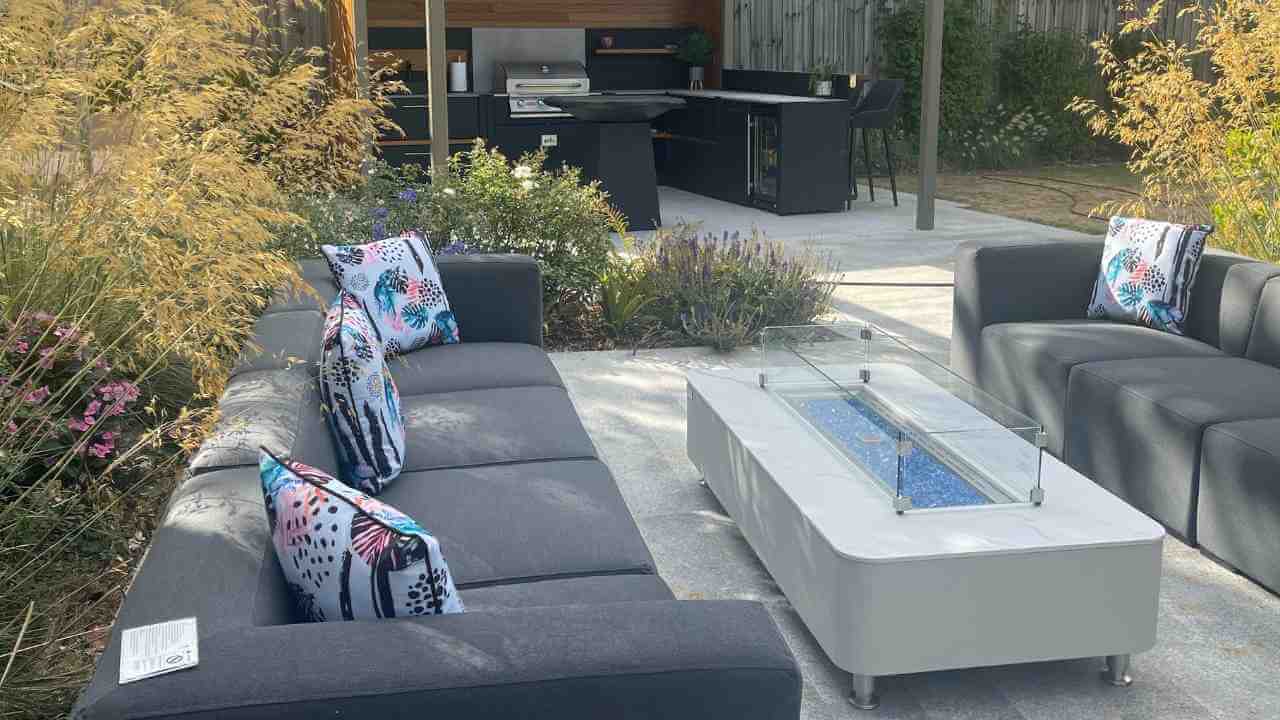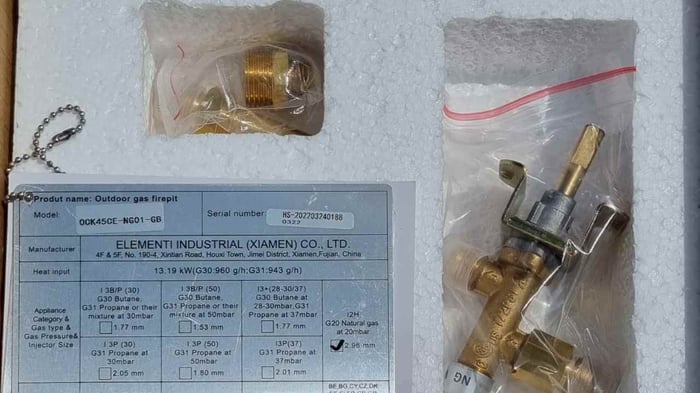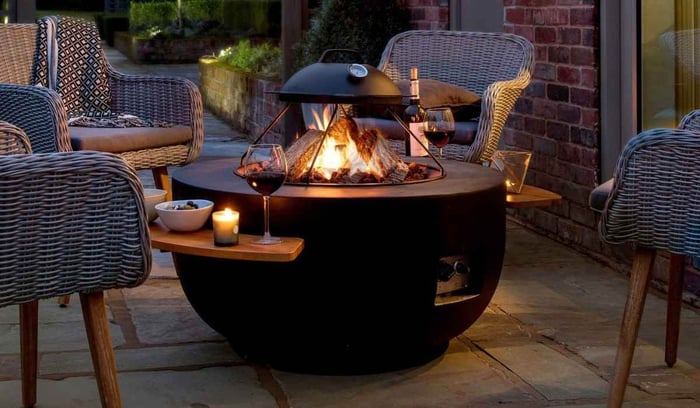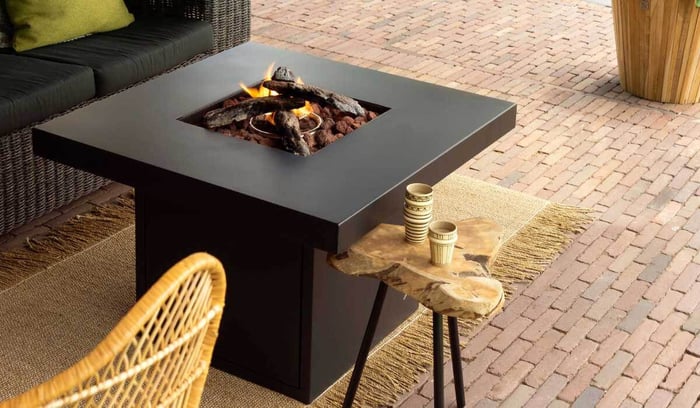The Basics of Propane Gas and Natural Gas
Before we explain how to convert a propane gas fire pit into a natural gas fire pit, let's first look at both fuel sources.
What is a Propane Gas Fire Pit
A propane gas fire pit is a type of fire pit that runs on propane gas as a fuel source. Propane is often referred to as LPG or liquefied petroleum gas.
Propane is a flammable gas stored in a tank and used for various applications, including fire pits and barbecues. The largest LPG storage tanks can fuel a house without a natural gas pipe.
Propane fire pits are typically portable and don't require a permanent gas line, making them a popular choice for outdoor spaces. They are easy to use and offer a convenient heat source and light for outdoor gatherings.
Propane is a byproduct of natural gas.
What is a Natural Gas Fire Pit
A natural gas fire pit is a type of fire pit that runs on natural gas as a fuel source.
Natural gas is a fossil fuel for heating, cooking, and powering appliances.
In the case of fire pits, natural gas is piped directly into the fire pit from a main gas line, eliminating the need for a propane tank.
Natural gas fire pits can also be known as permanent fire pits, as they are connected to an endless gas supply and don't require frequent refilling like propane fire pits.
This provides a convenient and reliable source of fuel for the fire pit. The term "natural gas fire pit" is the most commonly used, but they can also be referred to as "mains gas fire pits."
Choosing The Right Fuel Source For Your Requirements
Propane fire pits are often chosen for their portability and convenience. They are easy to set up and don't require a permanent gas line, making them an excellent choice for outdoor spaces where a natural gas line may not be available. They do require refilling.
On the other hand, natural gas fire pits are often chosen for their convenience and reliability. They are connected to a permanent gas supply and don't require frequent refilling, making them an excellent choice for people who want a fire pit that is always ready.
Natural gas fire pits are also more environmentally friendly than propane fire pits, as they emit fewer pollutants and don't require producing and transporting propane fuel.
Ultimately, the choice between a propane or natural gas fire pit depends on your personal preferences and the specific needs of your outdoor space.
Both fuel sources have advantages and disadvantages, and it's essential to consider cost, convenience, environmental impact, and safety when deciding.
Overview Of Converting Propane Fire Pits To Natural Gas
Converting a propane fire pit to natural gas requires the expertise of a professional and usually involves replacing certain parts of the fire pit.
The process involves disconnecting the propane tank and connecting the fire pit to a natural gas line.
It's crucial to prioritise safety during the conversion and to follow proper procedures and guidelines. Please always take advice from a professional and not from the advice you read online!

How Does Propane Work In Fire Pits?
Propane is a flammable hydrocarbon gas. In fire pits, propane is stored in a portable tank and is used to fuel the fire.
Propane is stored under pressure and is colourless and odourless. Propane companies add a compound called mercaptan, which smells like rotten eggs, so that you can identify any leaks.
A regulator is used to regulate the pressure and control the flow of propane from the tank to the fire pit, and a control valve is used to adjust the size of the flame to ensure constant pressure when in use.
The propane is burned in the fire pit to create heat and light, creating a warm and inviting atmosphere in your outdoor space.
Propane fire pits are convenient and easy to use, and they can be used in areas where a natural gas line is unavailable.
Propane is a clean-burning fuel that is relatively safe and efficient, making it a popular choice for outdoor spaces and remote locations.
How Does Natural Gas Work In Fire Pits?
Natural gas is a fossil fuel composed primarily of colourless and odourless methane. It is piped directly into homes and businesses from a main gas line. It is a fuel source for heating, cooking, powering appliances and generating electricity.
Natural gas is used to fuel the fire in fire pits, much like propane. A gas line is connected to the fire pit, and a control valve is used to adjust the size of the flame.
The natural gas is burned in the fire pit to create heat and light, creating a warm and inviting atmosphere in your outdoor space. Natural gas fire pits are convenient and easy to use, offering a reliable and consistent fuel source.
Natural gas is considered a cleaner-burning fuel than other fossil fuels, and its widespread availability makes it a popular choice for many people. However, not all homes are connected to the main gas pipe network.
Propane and Natural Gas Costs Compared
In general, in pure fuel terms, natural gas will be cheaper than natural gas. However, other factors to consider are installation and maintenance costs.
Propane is sold in portable tanks, and the cost of propane can be affected by factors such as transportation and storage. The cost of propane can also be affected by the demand for the fuel, and prices can fluctuate as a result.
On the other hand, natural gas is piped directly into homes and businesses from a main gas line, and the cost is often more stable and predictable than propane. However, market conditions can still affect natural gas, and prices fluctuate.
The cost of installing a propane or natural gas fire pit can vary depending on several factors, including the type of fire pit, the complexity of the installation, and the location.
Installing a propane fire pit is often considered much less expensive than installing a natural gas fire pit. A propane fire pit can be placed in the garden and hooked up to a gas propane bottle, and you are ready to fire up.
A natural gas fire pit will require the installation of a main gas pipe to the location of your fire pit. It will also require installation by a gas engineer and an annual gas inspection. However, once connected, the inconvenience and cost of propane refills are more than offset.

Safety
It's important to note that both propane and natural gas fire pits can pose risks if not used properly or if they are not installed correctly.
It's important to follow all safety guidelines and seek professional advice when installing or using a natural gas fire pit or a propane gas fire pit with underground storage or piping.
Additionally, it's essential to regularly maintain and inspect your fire pit to ensure it is in good working condition and reduce the risk of accidents.
Can Propane Fire Pits be Converted to Natural Gas?
Before converting, checking if your fire pit is compatible with natural gas is important.
Some fire pits may not be designed to work with natural gas, so confirming compatibility with the manufacturer or gas engineer is essential.
This is an essential step. If you are uncertain, seek a professional's advice.
Implications of a Faulty Conversion
If a propane fire pit is converted to natural gas in a defective or improper manner, there can be profound implications for safety and performance. Some of the most common implications include the following:
-
Gas leaks
-
Poor performance
-
Safety hazards
-
Costly repairs
-
Warranty issues
It's essential to seek professional advice and to follow proper guidelines and instructions when converting a propane fire pit to natural gas.
This will help ensure the conversion is performed correctly and safely and reduce the risk of problems and hazards.
Seek Professional Advice
A gas engineer, such as a plumber or a gas technician, can help convert a propane fire pit to natural gas. They will have the knowledge, experience, and expertise to perform the conversion safely and correctly, and they will be able to ensure that all local codes and regulations are followed.
Additionally, a gas engineer will have access to the tools and equipment needed to perform the conversion. They can make necessary repairs or adjustments if the fire pit does not function as expected.
Access to Natural Gas Line
The first requirement is access to a main gas line. You may have mains gas in your house, but do you know where the gas pipes lay.
The next step after identifying the gas mains pipe is extending it to the location of the fire pit.
Extending a main gas line is complex and challenging; use a qualified gas engineer.
Several factors can impact the difficulty of extending a main gas line, including:
Distance: The extension's distance will impact the project's cost and complexity. The further the extension, the more materials and labour will be required.
Location: The location of the main gas line, as well as the location of other utilities and obstacles, can impact the difficulty of the extension.
Permits and regulations: Depending on where you live, you may need to obtain permits and follow specific rules when extending a main gas line. A gas engineer will be able to help you navigate these requirements.
Excavation: Depending on the location of the main gas line, excavation is likely required to install the extension. This can impact the difficulty and cost of the project.
Overall, extending a main gas line can be expensive, complex and involved, and it's best to seek the advice of a gas engineer or a professional landscape gardener.
They will be able to assess your specific needs and circumstances, and they will be able to provide you with a detailed plan for the extension process, including the steps that will be taken and the costs involved.

Required Components and Tools
This should be left to a professional and not attempted as a DIY project.
Here we share the required steps; please be aware that fire pits will be manufactured differently and may require different steps. Always consult and follow the manufacturer's instructions and the guidance given by a gas engineer.
The Conversion Process
Steps for converting a propane fire pit to natural gas
The process of converting a propane fire pit to natural gas typically involves the following steps:
-
Check manufacturer's instructions: Before converting your fire pit, it's essential to check the manufacturer's instructions to ensure that the conversion is possible. Some fire pits may not be designed to be converted, so checking this first is important.
-
Obtain necessary components: If your fire pit can be converted, you must obtain the required components to complete the conversion. This may include a natural gas hose, a gas shut-off valve, and a gas orifice. The gas fire pit manufacturer is the usual source of the conversion kit.
- Using a conversion kit from another fire pit manufacturer is not advisable.
-
Turn off the gas supply: This will ensure your safety while working on the fire pit.
-
Disconnect the propane hose: Remove it from the fire pit and disconnect it from the propane tank.
-
Install the natural gas hose: Connect the natural gas hose to the fire pit and the gas shut-off valve. Make sure that all connections are tight and secure.
-
Install the gas orifice and valve: You replace the propane parts for the natural gas equivalents.
-
Test the conversion: Once the natural gas hose and orifice have been installed, turn the gas supply back on and test the fire pit to ensure it functions properly.
It's important to note that converting a fire pit from propane to natural gas can be a complex and potentially dangerous process, and it's best to seek the advice of a gas engineer.
Here are more detailed instructions with images for converting a Modeno/Elementi Fire propane to natural gas.
And Finally
In conclusion, converting a propane fire pit to natural gas can offer several benefits, including improved reliability and convenience.
However, it's essential to consider factors such as natural gas availability and installation costs before switching.
Overall, converting a propane fire pit to natural gas can be a great way to enjoy the benefits of natural gas in your outdoor living space. Just be sure to follow proper steps and guidelines, and seek the advice of a gas engineer, to ensure a successful conversion.
Subscribe to our email
Enter your email address below for a monthly email with links to all the latest blog posts. Simple unsubscribe at any time.





